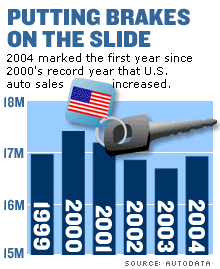DETROIT (CNN/Money) -
The North American International Auto Show here this week is a celebration of products and promise from automakers from around the globe, but for the home teams, there's less than usual to cheer about.

The traditional Big Three -- General Motors Corp. (Research), Ford Motor Co. (Research) and Chrysler Group, the North American unit of DaimlerChrysler (Research) -- have continued to lose ground to the overseas-based manufacturers. Only Chrysler Group posted a gain in U.S. market share this year, and only by a sliver. Toyota Motor Co., now the No. 4 U.S. automaker, could make the term "Big Three" obsolete in the near future. And it could soon topple GM from its long-held position as the world's largest automaker in terms of global sales.
Perhaps of greater concern than the old story of market share woes is the weak profit outlook for the U.S. industry. GM and Ford both lost money on their core auto operations in the third quarter, depending on the contributions of their finance units to be profitable. The narrow profits came despite relatively solid industrywide U.S. sales of 16.9 million cars and light trucks last year, up 1.4 percent, and the first increase in U.S. sales since 2000's record year.
"The sales continued to be strong," said Michael Flynn, an auto expert at the University of Michigan. "It's been a while since we had the typical downturn. But the domestic industry is having real trouble making money in this market. Unit sales have been good. Everything else has been problematic."
Health care costs are one of the key competitive problems for the Big Three, particularly because of their large base of retirees and their families. Most of the productivity gaps have closed between the Big Three assembly plants and the so-called "transplant" facilities in North America that produce cars for Toyota, Honda Motor Co. and other overseas manufacturers. The Harbor Report, which measures productivity, says that the gap between GM and Toyota's North American plants is now less than four hours per vehicle, less than half the gap of only five years ago. Ford and Chrysler are also making productivity gains, with Chrysler passing Ford in the most recent rankings.
Unhealthy feeling
But the younger age of the transplants' factories means a younger work force with lower health care costs. It also means almost no retiree base. This is a competitive problem Big Three carmakers can do little to address in the near term, but one they cannot afford to ignore.
The Center for Automotive Research estimates that retiree health care costs add nearly $1,000 per vehicle to each of the Big Three's cars and trucks. And even though a worker at a Toyota plant here will see close to the same wage and benefit package as his Big Three counterpart, the CAR estimates that the difference in health care costs due to the older work force is responsible for most of the $1,300 difference in operational labor costs.
"They've closed the productivity gap wonderfully, but they had to do so, because it's the thing they could address," said CAR's Sean McAlinden.
And the competition from Asian automakers such as Toyota isn't expected to slow significantly any time soon, even if Toyota's double-digit percentage sales growth in the U.S. market becomes more difficult to maintain as it gets larger.
"My opinion is there's still a lot of upside for Toyota," said Burnham Securities analyst David Healy "They're expanding capacity, still introducing models (in market segments) where they haven't been. They've got a technological lead in (fuel efficient) hybrids. They're aggressively expanding here still."
Better times ahead?
Still, a survey of more than 100 top auto executives from around the world by accounting firm KPMG found that they believe better times may be on the horizon. The survey found that 23 percent expect overall auto-industry profitability to be greatest in 2006, and another 16 percent believe strong profits will return as soon as 2005. In other recent KPMG surveys, most executives saw a return to profits three or more years away.
"In prior years, saddled with heavy incentives and a sagging economy, industry executives pushed profitability out as far as they could," said Brian Ambrose, national industry leader for KPMG's automotive practice. "Our survey this year has definitely found improved profit levels emerging sooner rather than later, and this is very encouraging."
The survey also found that 55 percent of executives said they expect to see North American brands' global market share to remain the same or increase over the next five years, up from 42 percent in the year-earlier survey. Those surveyed still expect the Asian automakers to gain ground, but see European automakers losing ground faster in the coming years.
But some analysts aren't convinced the turnaround is really that close at hand.
"There's no question the Big Three have improved on a product by product comparison. But there are still a whole lot of buyers who don't include them on their shopping list. It's going to take some time before the buyers get brought back in to the Big Three showrooms."
That's one of the reasons media circuses such as this week's auto show are important. The attention that the new vehicles get -- or fail to get -- will go a long way to determining how big the Big Three can remain, both in the near and long term.

|